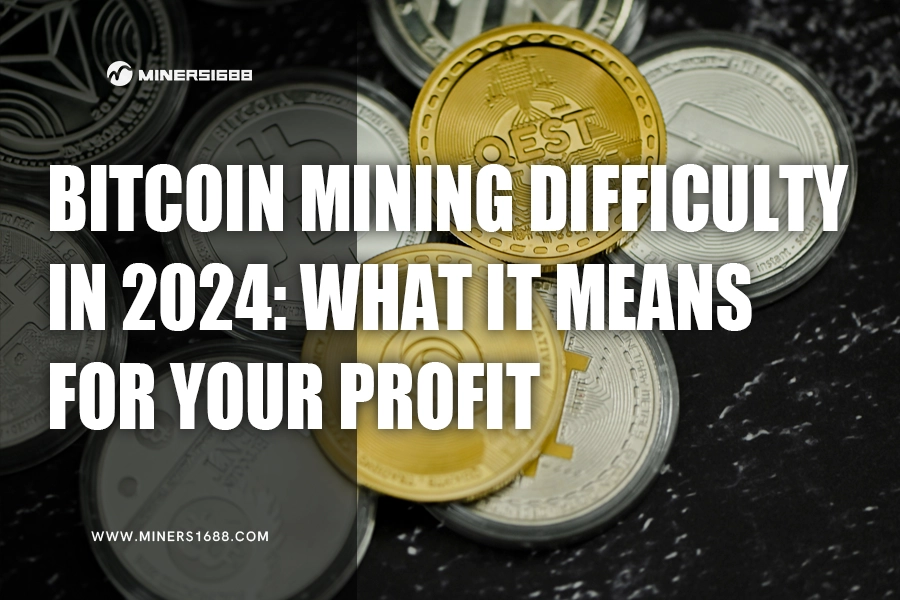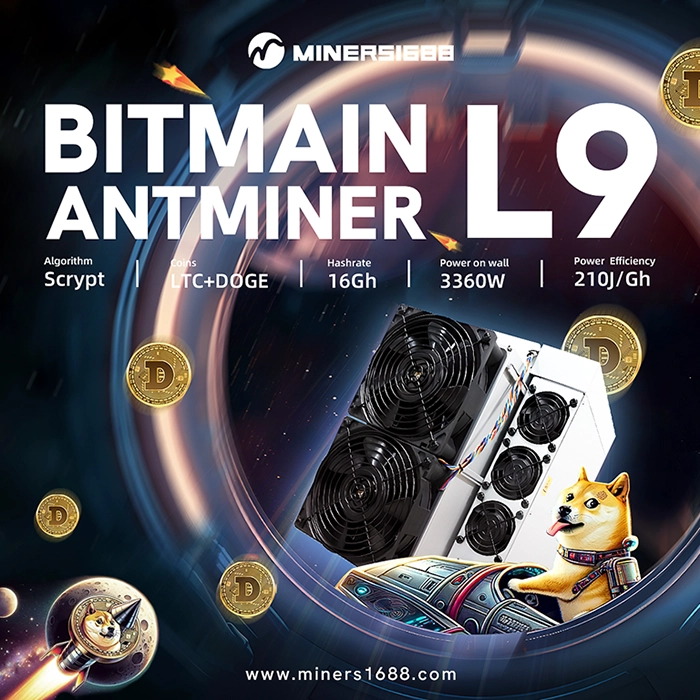Bitcoin mining has been one of the most dynamic, and at times lucrative, sectors in cryptocurrency. But as we head into 2024, one major factor looms over anyone looking to profit from mining: Bitcoin mining difficulty. Simply put, this difficulty level controls how hard it is to earn Bitcoin by mining, and it’s constantly evolving, often making profitability a moving target. In recent years, as mining difficulty has steadily increased, only miners with access to powerful, efficient equipment and low-cost electricity have been able to stay profitable. In 2024, the stakes are even higher.
To understand how mining difficulty can make or break your earnings, it’s crucial to know what factors influence it, how it’s calculated, and, ultimately, how it affects your potential profits. This article will guide you through all aspects of Bitcoin mining difficulty and provide actionable insights so you can make informed decisions about whether mining Bitcoin is worth the investment. Whether you’re an experienced miner or just exploring the idea, this guide will arm you with the knowledge needed to assess the profitability of mining in today’s competitive landscape.

What Is Bitcoin Mining Difficulty?
Bitcoin mining difficulty is a metric that determines how challenging it is to mine a new block on the Bitcoin blockchain. It’s a core part of the Bitcoin network’s design, ensuring that blocks are mined approximately every 10 minutes, regardless of how many miners are participating. But why does this difficulty level even exist? In essence, mining difficulty is a balancing mechanism to keep the network secure and stable. When more miners enter the network, competition increases, which naturally drives up the difficulty. Conversely, if miners exit the network, the difficulty decreases to maintain the block creation rate.
Why Difficulty Adjusts
The Bitcoin network recalibrates mining difficulty every 2016 blocks (roughly every two weeks) to ensure that the average time to mine each block remains close to 10 minutes. This adjustment mechanism accounts for changes in the overall “hash rate,” or the collective computational power of all miners. As more miners join and add computing power, the network makes it harder to mine blocks by increasing difficulty. This helps to prevent blocks from being mined too quickly and maintains the fixed supply schedule, a cornerstone of Bitcoin’s value proposition as a scarce digital asset.
Historical Context
Since Bitcoin’s inception, mining difficulty has grown exponentially. In the early days, mining difficulty was low enough that hobbyists could mine Bitcoin from personal computers. But as Bitcoin gained value and more participants joined, difficulty increased, requiring miners to use specialized hardware (ASICs) and large amounts of electricity to stay profitable. Today, mining difficulty reflects the sheer competitiveness of the industry, as well as its evolution from a small-scale hobby to an industrial endeavor requiring substantial resources.
Why Bitcoin Mining Difficulty Matters for Profitability
Mining difficulty is more than just a technical term—it directly impacts a miner’s bottom line. As difficulty increases, each miner’s share of block rewards becomes smaller unless they’re able to contribute significant computational power. This means that profitability is a moving target, one that depends heavily on a miner’s hardware efficiency and energy costs.
Impact on Earnings
The primary way difficulty affects profitability is by influencing the amount of Bitcoin a miner can earn over a given period. As more miners compete and the difficulty rises, it takes more computational effort (and therefore more time and energy) to mine the same amount of Bitcoin. When difficulty rises sharply, only miners with the latest, most powerful equipment can maintain a high level of rewards. For smaller miners, it can lead to drastically reduced earnings or even unprofitability.
Profit Margins and Cost Considerations
Higher mining difficulty means higher operating costs, especially for electricity and cooling, which are already substantial expenses in mining operations. Miners who operate in areas with cheaper electricity can better absorb these rising costs, but for those with high utility rates, profitability can quickly diminish. Additionally, as difficulty increases, miners often need to upgrade their hardware to keep up. These hardware upgrades represent significant capital investments, impacting profit margins and stretching the timeline to achieve break-even points. For those considering entering the mining market in 2024, understanding how difficulty impacts operating costs is essential for making informed decisions.
How Mining Difficulty Is Calculated
Bitcoin mining difficulty is recalibrated based on the network’s total computational power, known as the hash rate. This calculation ensures that blocks are added to the blockchain roughly every 10 minutes. Here’s a simplified look at how it works:
The Technical Details
Mining difficulty is calculated every 2016 blocks by evaluating the time it took to mine the previous 2016 blocks. If miners completed those blocks in less than two weeks, the difficulty increases; if it took longer than two weeks, the difficulty decreases. The adjustment factor aims to bring block production time back in line with the 10-minute average. This balance is achieved through an algorithm that compares actual mining time with the ideal time, ensuring block creation stays consistent, despite fluctuations in the number of miners.
Hash Rate and Difficulty
The global hash rate—the sum of all miners’ computational power—directly influences mining difficulty. When the hash rate rises due to more miners or more powerful hardware, the network automatically increases the difficulty to maintain the 10-minute block time. This creates a competitive relationship: as hash rate rises, so does difficulty, making mining harder and more resource-intensive. For miners, this interplay between hash rate and difficulty is key to understanding profitability, as it can determine the feasibility of mining with existing hardware or the need for costly upgrades.
Current Trends in Bitcoin Mining Difficulty (2024)
In 2024, Bitcoin mining difficulty continues to rise as the global mining landscape evolves. Several factors are driving this increase, from greater participation by mining companies to technological advancements in mining hardware. Understanding these trends can help miners anticipate potential challenges and make strategic decisions.
Difficulty Predictions for 2024
Experts anticipate that Bitcoin’s mining difficulty will continue to rise throughout 2024. With increasing interest from institutional mining operations and improved mining equipment, the network’s hash rate is expected to grow, pushing difficulty upward. Some forecasts even suggest record highs for difficulty levels as more players join the industry and compete for block rewards.
External Factors Affecting Difficulty
Multiple factors contribute to the anticipated rise in mining difficulty. One is the ongoing advancement in ASIC (application-specific integrated circuit) technology. Newer ASIC models are significantly more powerful and energy-efficient, enabling miners to contribute more hash power to the network without proportionally increasing costs. Additionally, regulatory trends, particularly in North America and parts of Asia, have made mining more accessible, drawing more participants into the market. These elements collectively support a higher hash rate, which in turn escalates mining difficulty.
Is Bitcoin Mining Still Profitable in 2024?
As mining difficulty rises, a critical question for anyone in the industry is: Can Bitcoin mining still be profitable in 2024? The answer depends on various factors, including electricity costs, hardware efficiency, and the ability to manage operational expenses. Let’s break down the key elements that affect profitability.
Key Profitability Factors
- Electricity Costs: Power consumption is one of the largest expenses in mining, and local electricity rates can make or break profitability. Miners operating in regions with low electricity costs, such as parts of North America, Eastern Europe, and Central Asia, have an advantage. For example, miners in regions with rates below $0.05 per kWh can potentially remain profitable even as difficulty rises, whereas those with higher rates may find it increasingly challenging to break even.
- Hardware Investment: The mining hardware you use greatly influences profitability. High-efficiency ASIC models, such as the Antminer S19 XP, offer improved performance at lower energy consumption, helping miners maximize output per watt. However, these advanced machines come with a hefty price tag, often ranging from $5,000 to $10,000. For those looking to enter the market, evaluating the cost-to-performance ratio of newer models is essential.
- Break-Even Analysis: Calculating the break-even point is a key step in assessing mining viability. This involves comparing your total operational costs with the expected earnings over time. For example, if a miner spends $0.04 per kWh on electricity and has an efficient ASIC machine, they may still find profitability, even with rising difficulty. However, lower-efficiency hardware or higher energy costs could extend the time needed to break even, potentially making mining a long-term investment rather than a quick return.
How to Adapt to Rising Bitcoin Mining Difficulty
With Bitcoin mining difficulty at unprecedented levels in 2024, miners must adapt to maintain profitability. Here are some effective strategies to counteract rising difficulty and optimize your mining operations.
1. Efficient Mining Hardware
Investing in high-efficiency ASIC miners is essential for remaining competitive. Newer ASIC models like the Antminer S19 XP and Whatsminer M50 offer significantly improved hash rates per watt, meaning they can produce more computational power while consuming less electricity. Although these machines come with high upfront costs, their enhanced efficiency can offset operational expenses, helping miners to maximize profitability in the face of increasing difficulty.
2. Mining Pool Options
Joining a mining pool is one of the most practical ways to navigate high difficulty levels. Mining pools allow individual miners to combine their computational power, thereby increasing their chances of earning consistent rewards. While joining a pool means sharing rewards with other miners, it can smooth out earnings and reduce the impact of difficulty spikes. For miners with limited hash power, participating in a reputable mining pool can be a strategic choice to ensure steady returns.
3. Alternative Energy Solutions
Reducing electricity costs is crucial to staying profitable in 2024. Many miners are exploring renewable energy sources like solar and wind power to minimize expenses. For example, some mining operations are setting up near hydroelectric plants or partnering with energy companies to utilize surplus energy, especially in regions where electricity costs fluctuate seasonally. Another option is to harness stranded gas—natural gas that would otherwise be wasted—to power mining operations. These approaches not only reduce costs but can also provide a more sustainable and environmentally friendly way to mine Bitcoin.
By adopting these strategies, miners can better navigate the challenges posed by rising difficulty levels, making their operations more resilient and cost-effective in the long run.
Conclusion
Bitcoin mining in 2024 presents both exciting opportunities and formidable challenges. Rising mining difficulty, driven by increased competition and technological advancements, means that profitability is no longer guaranteed. For miners, success hinges on a combination of factors: high-efficiency hardware, access to low-cost or renewable energy, and, often, collaboration through mining pools to navigate the impacts of escalating difficulty.
Adapting to these dynamics requires a proactive approach. Miners must continually evaluate their setup, assess operating costs, and stay informed about regulatory changes and industry trends. Ultimately, mining in 2024 is a balancing act—those who can leverage efficient resources and strategic planning will have the best chance at maintaining profitability in this competitive space.
If you’re considering or currently involved in Bitcoin mining, now is the time to dig deeper into your calculations. Use a mining profitability calculator, consult additional resources, and keep a close eye on the evolving landscape to make well-informed decisions about your mining strategy.


